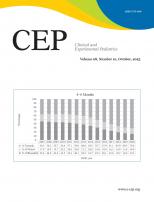2. Di Renzo L, Gualtieri P, Pivari F, Soldati L, Attinà A, Cinelli G, et al. Eating habits and lifestyle changes during COVID-19 lockdown: an Italian survey. J Transl Med 2020;18:229.


5. Tilg H, Effenberger M, Adolph TE. A role for IL-1 inhibitors in the treatment of non-alcoholic fatty liver disease (NAFLD)? Expert Opin Investig Drugs 2020;29:103–6.


6. D’Antongiovanni V, Fornai M, Pellegrini C, Blandizzi C, Antonioli L. Managing obesity and related comorbidities: a potential pharmacological target in the adenosine system? Front Pharmacol 2021;11:621955.


8. World Health Organization. Growth reference data for 5–19 years. BMI-for-age (5–19 years). Geneva (Switzerland): World Health Organization, 2016.
10. Eslam M, Alkhouri N, Vajro P, Baumann U, Weiss R, Socha P, et al. Defining paediatric metabolic (dysfunction)-associated fatty liver disease: an international expert consensus statement. Lancet Gastroenterol Hepatol 2021;6:864–73.


12. Eslam M, Newsome PN, Sarin SK, Anstee QM, Targher G, Romero-Gomez M, et al. A new definition for metabolic dysfunction-associated fatty liver disease: an international expert consensus statement. J Hepatol 2020;73:202–9.

14. Hassan MH, Saleem TH, Rashad A, Abd-El Hak ZA, Mohammed HA, Abdelhady M. Adenosine deaminase activity and ADA G22A gene polymorphism among a cohort of Egyptian patients with pulmonary and extra pulmonary tuberculosis. SVU Int J Med Sci 2025;8:12–26.
15. Swellam M, Gabal KM, Youssef SS. Interleukin-1 receptor antagonist gene polymorphism and hepcidin in rheumatoid arthritis: Correlations with clinical and laboratory indices of disease activity. IUBMB Life 2013;65:883–8.


17. Abdelbaseer KA, Mostafa SA, Abd-Elmawgood EA. Impact of obesity on asthma severity and control in school aged children. SVU Int J Med Sci 2020;3:87–96.

21. Elsaied AA, Abdallah EA, Mohammed HA, Mohamed ZA. Metabolic syndrome and insulin resistance in obese patients. SVU Int J Med Sci 2024;7:484–90.

22. Anagnostis P, Athyros VG, Tziomalos K, Karagiannis A, Mikhailidis DP. Clinical review: the pathogenetic role of cortisol in the metabolic syndrome: a hypothesis. J Clin Endocrinol Metab 2009;94:2692–701.

23. Ahmed AE, Eleshery UM, Rashwan NI, Abed EE. Waist circumference as an indicator for metabolic syndrome in children: a narrative review. SVU Int J Med Sci 2024;7:798–808.

25. Hamed AM, Hassan AE, Younis MM, Kamal AM. Prevalence of obesity and overweight among primary schools children in Qena, Egypt. Egypt J Hosp Med 2019;77:4899–905.

26. Saleh Abdel-Fattah S, Mohamed G, Mohamed El-Mazahy M. Obesity among primary school children in Port Said governorate; prevalence and associated factors. Port Said Sci J Nurs 2021;8:170–89.

27. Abd El-Aty NS, Osman SR, Ahmed ES, GadAllah MA. Overweight and obesity prevalence among Upper Egypt primary schools' children using Egyptian and CDC growth charts. Appl Nurs Res 2020;56:151346.


28. Dohein AM, El-Shafie AM, Hogran HH. Prevalence of obesity in primary school children living in Alexandria governorate. Menoufia Med J 2014;27:529–32.

29. Al-Jawaldeh A, Abul-Fadl A. Regional disparities in prevalence of obesity among school-aged children in Egypt: a country case study from The Eastern Mediterranean Region. Indian J Child Health 2021;8:262–8.


31. Chiarelli F, Marcovecchio ML. Insulin resistance and obesity in childhood. Eur J Endocrinol 2008;159 Suppl 1:S67–74.


37. Johansen MJ, Gade J, Stender S, Bøjsøe CF, Lund MA, Chabanova E. The effect of overweight and obesity on liver biochemical markers in children and adolescents. J Clin Endocrinol Metab 2020;5:dgz010.


40. Targher G, Day CP, Bonora E. Risk of cardiovascular disease in patients with nonalcoholic fatty liver disease. N Engl J Med 2010;363:1341–50.


44. Jadhav AA, Jain A. Elevated adenosine deaminase activity in overweight and obese Indian subjects. Arch Physiol Biochem 2012;118:1–5.


46. Takhshid MA, Zahediannejad Z, Aboualizadeh F, Moezzi L, Ranjbaran R. G22A polymorphism of adenosine deaminase and its association with biochemical characteristics of gestational diabetes mellitus in an Iranian population. Iran J Med Sci 2015;40:170–4.


48. Strandberg L, Lorentzon M, Hellqvist A, Nilsson S, Wallenius V, Ohlsson C, et al. Interleukin-1 system gene polymorphisms are associated with fat mass in young men. J Clin Endocrinol Metab 2006;91:2749–54.


50. Bojarczuk A, Garbacz A, Zekanowski C, Borzemska B, Ci˛eszczyk P, Maculewicz E. Systematic review of IL-1, IL-4, IL-6, IL-10, IL-15, and IL-18 gene polymorphisms and metaanalysis of IL-6 variant and its association with overweight and obesity risk in men. Int J Mol Sci 2024;25:13501.



52. Nobili V, Alkhouri N, Bartuli A, Manco M, Lopez R, Alisi A, et al. Severity of liver injury and atherogenic lipid profile in children with nonalcoholic fatty liver disease. Pediatr Res 2010;67:665–70.


53. Iwani AK, Jalaludin MY, Zin RM, Fuziah MZ, Hong JY, Abqariyah Y, et al. TG: HDL-C ratio is a good marker to identify children affected by obesity with increased cardiometabolic risk and insulin resistance. Int J Endocrinol 2019;2019:8586167.


54. Demiral M. A novel diagnostic tool in determining insulin resistance in obese children: triglyceride/HDL ratio. J Surg Med 2021;5:1144–7.

55. Ting Y, Jalaludin MY, Zaini AA, Mohamed R. Triglyceride to high-density lipoprotein cholesterol ratio is an independent predictor of liver fibrosis among pediatrics non-alcoholic fatty liver disease. Front. Endocrinol 2022;13:1071350.







 PDF Links
PDF Links PubReader
PubReader ePub Link
ePub Link PubMed
PubMed Download Citation
Download Citation


